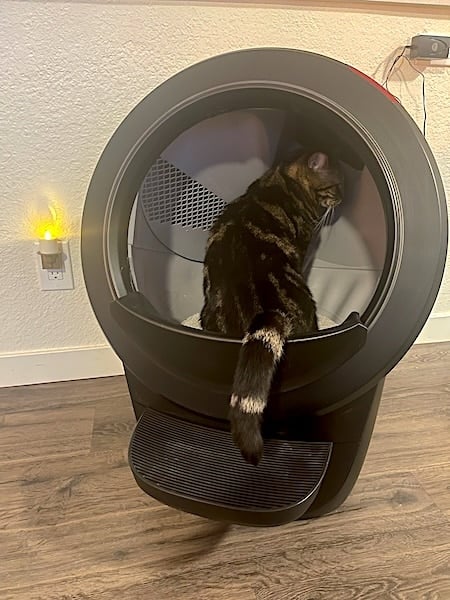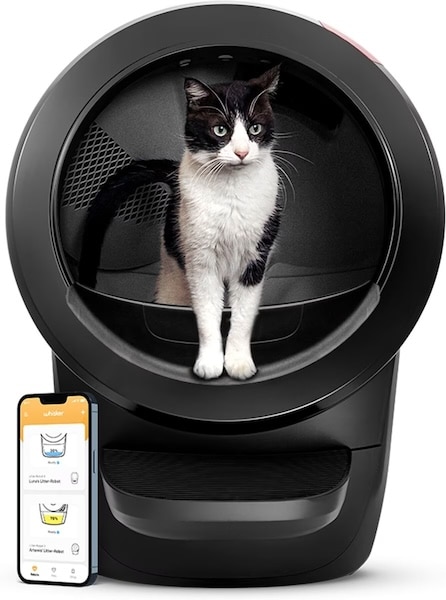- This post contains affiliate links. Read more here.
Our product testers received a free Litter Robot 4 in exchange for an honest review.
The Litter Robot 4 is one of the most popular automatic litter boxes on the market for a good reason. With a whisper-quiet self-cleaning cycle, an odor-sealed waste drawer, and a capacity big enough for large cats, it’s a dream for cat parents. But it also comes with a top-tier price point: $649 to $699.
For cat parents contemplating the jump to an automatic litter box, it can be tempting to opt for a cheaper model—or to stick with a manual classic that you know pleases your cat. Our reviewers compare the Litter Robot 4 to other models, then weigh the pros and cons for their picky kitties.
Key Features of the Litter Robot 4
Like most high-value automatic litter boxes, the Litter Robot 4 is equipped with a rotating drum that sifts your cat’s waste from the clean litter and deposits it in a sealed drawer beneath the bowl. Advanced sensors start the rotation only once your cat has left the box and pause the process if your cat tries to reenter.
Pet parents just have to open the lined drawer, take out the bag of waste, and put it in the trash once a week for most single-cat households. Deep cleaning of the litter box should take place once per month.
The Litter Robot 4 also features:
- A large, open drum that comfortably accommodated even 15-pound test kitties
- WiFi connectivity and an app that tells you how full the waste drawer is, when the litter needs refilling, when your cat uses the box, and even how much they weigh
- An adjustable cleaning cycle that runs automatically or can be triggered via button
- A night light feature you can turn on or off
It’s also possible to get a discount on a Litter Robot 4, which regularly goes on sale.
Find on Whisker Find on Chewy Find on Amazon
How the Litter Robot Compares
Rover test kitties found that Litter Robot 4 has a set of features comparable to several of the high-end self-cleaning litter boxes on the market, like the Leo’s Loo Too, the Petkit PuraMax, and the earlier Litter Robot 3. But how well it performs them put it in a class of its own.
Litter Robot 4 vs Leo’s Loo Too
Leo’s Loo Too presents the toughest competition of all the litter boxes we’ve tested. Retailing for around $699, it’s priced comparably to the Litter Robot 4, and it comes with many of the same features.
Leo’s Loo Too, however, differs with:
- A slightly smaller, more enclosed drum
- A smaller waste drawer with a carbon filter and anti-bacterial UV light
- Smart home integrations for Google Home and Alexa
- Anti-jam technology (useful for kitties who like to leave toys in the litter box)
Both litter boxes offer premium features, but our testers felt the Litter Robot 4 is likely the better choice for larger cats and multi-cat families, while the Leo’s Loo Too might be the pick for users who love smart-home integrations.

Zorian the Rover test kitty had his weight taken and his morning bathroom visit recorded via the app.
Litter Robot 4 vs Petkit PuraMax
At $499–$599, Petkit’s PuraMax is a popular budget pick, and it’s definitely a step up from manual scooping. But it also illustrates what you’re really paying for with the Litter Robot 4. Despite a first-class app, our testers found the odor control of the PuraMax’s waste bin less advanced, and its design made it possible for messy kitties to pee between the drum and the bin.
The PuraMax differs principally in:
- A smaller footprint, better for tight quarters
- A slightly louder cleaning mechanism
- Less effective odor control, requiring more frequent changes
- Integration with smart home systems like Alexa and Google Assistant
- Removable components that simplify deep cleaning
We like the PuraMax for small spaces, but the odor control and quiet of the Litter Robot 4 are hard to beat.
Litter Robot 4 vs Litter Robot 3
Whisker’s previous model, the Litter Robot 3, offers pet parents a more affordable automatic box with fewer bells and whistles. It retails for $499 to $549, a full $150 to $200 less than the newer model.
In exchange, pet parents give up some features and key upgrades. The Litter Robot 3 is:
- Bulkier, with a bigger base (+1.75 inches in diameter) and smaller drum (-4 inches in diameter)
- A little noisier, with a more noticeable cleaning cycle
- Unable to connect to WiFi (without the purchase of a $99 Upgrade module)
- Equipped with a slightly smaller, less tightly sealed waste drawer
- Built to run on a set timer, not a customizable one
- Missing “Night Mode” that offers kitties a light during set hours
We found the Litter Robot 3 a good reliable option, but our testers put a premium on the larger, better-sealed box for more powerful odor control and less frequent changes. Large cats will likely prefer the roomier new model, while skittish cats have a better chance of tolerating the Litter Robot 4’s quiet motor.
For smaller, more intrepid kitties, however, the Litter Robot 3 is likely to serve just fine. And if their pet parents are willing to put up with a slightly bulkier base and no fancy app, they’ll be pleased with the cheaper model too.

Zorian is a big, 15-pound cat, but the Litter Robot 4 is comfortably roomy for him.
Will My Cat Like the Litter Robot 4?
Whether your cat (or cats) will adapt to an automatic litter box was a pressing question for our test kitties. Our testers concluded the Litter Robot 4 is the best choice you can make for a kitty you’re worried won’t adapt well to an automatic box.
The biggest obstacles most kitties face to self-cleaning models are the noise, the startling motion, and the top coverage. The Litter Robot 4 does its best to combat all three problems with a quiet motor, an open and roomy design, and sensor that keeps it from activating until your cat is firmly away from the box.
All our test kitties adapted to it successfully within a week, from cats new to automatic litter boxes to old pros who’d tried other models. To encourage your cat to use an automatic litter box, try the following:
- Put it where the old litter box was but…
- Leave the old litter box nearby.
- Add a scoop of litter from the old box to the new box with its clean litter.
- Don’t turn the automatic litter box on until your cat has successfully used it at least once.
- Once they’ve used the new box, let them see it run with you in the room.
- Stop scooping the old box to incentivize your kitty to use the new clean one.
- Leave cat toys and cat treats on the steps of the new litter box.

For skittish kitties, it’s nice to be able to delay the cleaning cycle or run it manually.
Recommendation
Our testers give the Litter Robot 4 paws up, our highest rating for an automatic litter box. Here’s who we think will have success:
- Kitties of all sizes, including large ones
- Multi-cat households
- Cats who prefer a more open style box
- Litter setups that benefit from powerful odor control
And here’s who we think is better advised to try a different model or a good traditional litter box:
- Users looking for more smart home integration
- Homes where floor space is at a premium
- The rare kitties who prefer a covered litter box
- Extremely skittish, shy, or scared cats who don’t tolerate mechanical noises or movements well




